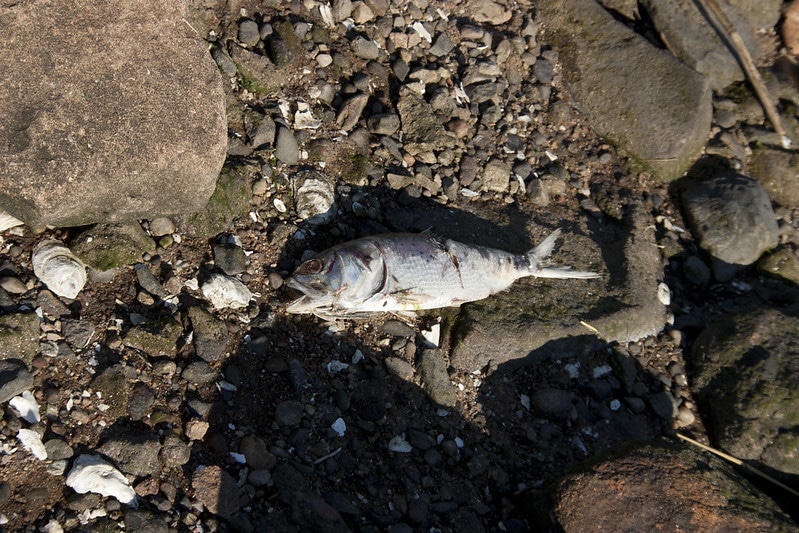In December 2020, scores of Atlantic menhaden fish, locally known as bunker fish, began washing up dead on the shores of the Long Island Sound. While some natural die-off is to be expected from schooling prey fish, the quantities in this event were higher than normal, prompting concern. Some experts believe that the mass die-off event is linked to climate change.
—
According to Bill Lucey of Save the Sound, a local organisation dedicated to taking positive environmental action in the region, greater numbers of bunker fish than usual stayed in the Long Island Sound past their typical migration point because the water stayed warmer for longer than is typical. The missed migration cue meant that large numbers of bunker fish were trapped when the water suddenly turned cooler; the unexpected cold left many of the bunker fish without their food supply of algae and plankton, which have died off due to lack of reproduction. The lethargy caused by cold and lack of food meant that many fish were unable to keep themselves out of the surf washing them onto the beach, and fish near the surface made for easy pickings from seagulls. Others simply died of exposure.
It is also possible that the die-off event in the Long Island Sound was higher than normal because the overall number of bunker fish has increased. Bunkers are migratory fish, spawning in the Chesapeake Bay off the East Coast of the United States, and migrate north for the summer months, before returning south. According to the Chesapeake Bay Foundation, bunkers are the “most important fish in the Bay” because their small size and nutrient-rich meat make them a critical link between the top and the bottom of the food chain. Predator fish, many of which have suffered from overfishing, climate change and other threats to their populations, rely on bunkers for food. By extension, a depressed bunker population will have a negative impact on the populations of striped bass, bluefish and weakfish, as well as on ospreys, dolphins and whales living in the Sound.
The water of the Chesapeake Bay is one of the most important nurseries for bunkers. Juvenile fish spend their first year of life in the Bay, protected from the open ocean. However, bunkers are popular for human harvesting, both as baitfish for recreational fishermen, and for fish oil, fish meal and fertiliser. For the past several decades, the bunker population in the Chesapeake has dropped significantly. However, the chart below shows a recent steady increase in bunker populations, which could indicate that conservation efforts over the past few years are beginning to work.
You might also like: Queensland Biodiversity: Beautiful One Day, Gone The Next?

This graph represents the average number of juvenile menhaden available (“abundance”), which has a direct impact for predators like striped bass and osprey. Unfortunately, the number of young menhaden produced in the Bay each year has been poor for the last 20 years (Source: MARYLAND DEPARTMENT OF NATURAL RESOURCES, FISHERIES SERVICE).
Successful management of bunker populations is essential for the rebound of endangered fish, whale and other marine species. In August 2020, the Atlantic States Marine Fisheries Commission announced a new management approach for harvesting bunkers. According to Carl LoBue, The Nature Conservancy’s New York Oceans and Fisheries Director, “If you want to have big fish, you need little fish for them to eat. And you only get big fish if you leave enough little fish in the ocean.” The new management system centers around the concept of Ecological Reference Points, also known as ERPs. In contrast to past management programmes, ERPs take a “holistic approach to fisheries management and set catch limits that take the health of the surrounding ecosystem into account, including the needs of species that depend on the fish population in question to survive” (Menhaden Recovery Helps Whales | The Nature Conservancy). In other words, they account for the needs of predator species and others in the food chain when determining the annual quota for prey fish, as opposed to prior strategies, which focused on human needs. As the second largest fishery in the United States, it’s easy to understand the domino effect of low bunker populations for the rest of the ecological hierarchy. The 2021 quota allocations based on ERPs have been published by the Atlantic States Marine Fisheries Commission.
According to The Nature Conservancy, previous efforts at increasing the bunker population led to a return of whales, dolphins and other marine favourites to hotspots such as New York Harbor, which led to an increase in tourism and recreation, a boon to the local economy from the increase in “wildlife watchers.” As Mr. LoBue puts it, “the new ERPs account for the value of the fish we leave in the water in addition to the value of those we take out of the water.” The trickle-down effect means that the “decision to adopt these ERPs are critically important to many other species, including those that people love to catch and watch, which boosts local economies along the entire Atlantic Coast” (nature.org).
While it’s always concerning to see die-off events, in this particular instance, it seems to be that the result of increased species population and the die-off was more or less proportionate. That being said, the increased water temperature later into the season may signal the start of a new kind of challenge for bunkers and is a marker that should be closely watched. Fortunately, investigations into viral or water-quality issues turned up no alarming results, so scientists remain optimistic that this past year may be the beginning of an environmental management success story.
Featured image by: Flickr

















